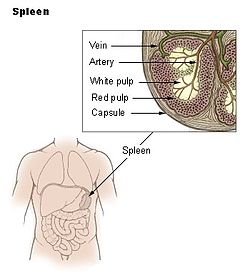Spleen
| Spleen | |
|---|---|

Human spleen removed from a cadaver
|
|

Spleen
|
|
| Details | |
| Precursor | Mesenchyme of dorsal mesogastrium |
| System | Immune system (lymphatic system and mononuclear phagocyte system) |
| Artery | Splenic artery |
| Vein | Splenic vein |
| Nerve | Splenic plexus |
| Identifiers | |
| Latin | Lien |
| Greek | splḗn–σπλήν |
| MeSH | A10.549.700 |
| TA | A13.2.01.001 |
| FMA | 7196 |
|
Anatomical terminology
[]
|
|
The spleen (from Greek σπλήν—splḗn) is an organ found in virtually all vertebrates. Similar in structure to a large lymph node, it acts primarily as a blood filter.
The spleen plays important roles in regard to red blood cells (also referred to as erythrocytes) and the immune system. It removes old red blood cells and holds a reserve of blood, which can be valuable in case of hemorrhagic shock, and also recycles iron. As a part of the mononuclear phagocyte system, it metabolizes hemoglobin removed from senescent red blood cells (erythrocytes). The globin portion of hemoglobin is degraded to its constitutive amino acids, and the heme portion is metabolized to bilirubin, which is removed in the liver.
The spleen synthesizes antibodies in its white pulp and removes antibody-coated bacteria and antibody-coated blood cells by way of blood and lymph node circulation. A study published in 2009 using mice found that the red pulp of the spleen forms a reservoir that contains over half of the body's monocytes. These monocytes, upon moving to injured tissue (such as the heart after myocardial infarction), turn into dendritic cells and macrophages while promoting tissue healing. The spleen is a center of activity of the mononuclear phagocyte system and can be considered analogous to a large lymph node, as its absence causes a predisposition to certain infections.
...
Wikipedia
